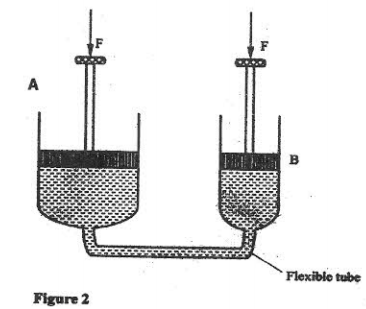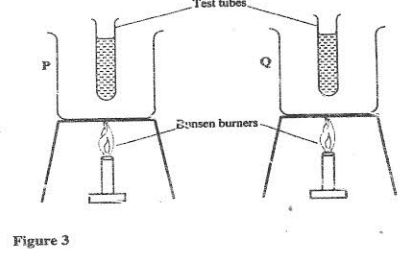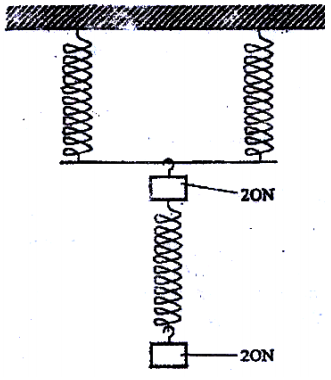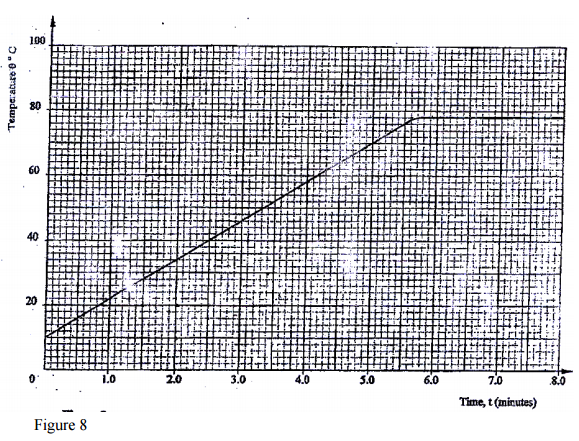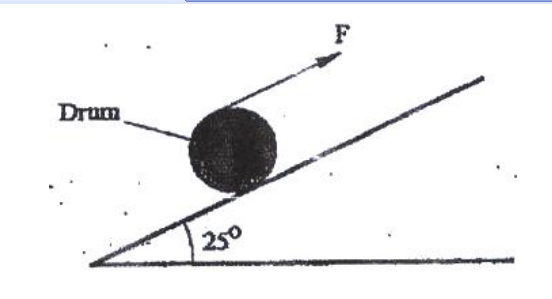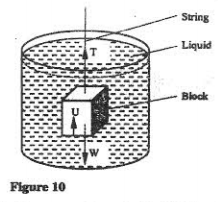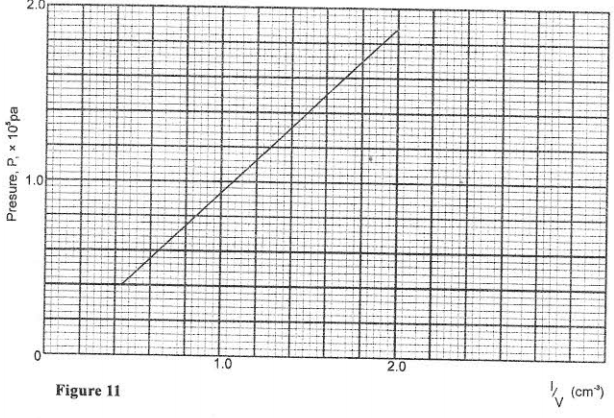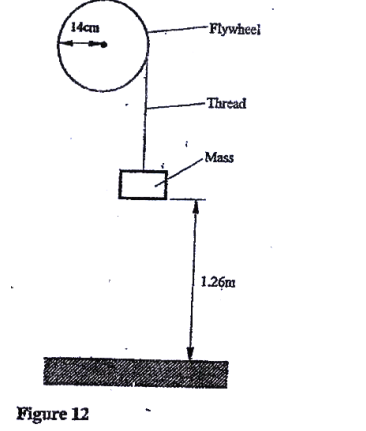SECTION A (25 marks)
Answer all questions in this section in the spaces provided
- In an experiment to measure the density of a liquid, a student filled a burette with a liquidto the 0 cm3 mark. Figure 1 shows a section of the burette showing the level of the liquid after 54.5 g of the liquid had been run out.
Determine the density of the liquid ( 3 marks) - In an experiment to determine the acceleration due to gravity, g, a student measured the period, T, and length L, of a simple pendulum. For a length L = 70.5 cm, the period T obtained as 1.7s. Given that T = 2π√ L/g, determine the value of g correct to two significant figures. ( 2 marks)
- A steel needle when placed carefully on water can be made to float. When a detergent is added to the water it sinks. Explain this observation.
- Figure 2 shows two cylinders containing a liquid and connected with a tight-fitting flexible tube. The cylinders are fitted with air- tight pistons A and B as shown.
When equal forces, F, are applied on the pistons as shown, it is observed that piston A moves up while B moves down. Explain this observation. (2 marks) - Two identical beakers A and B containing equal volumes of water are placed on a bench. The Water in A is cold while in B it is warm. Identical pieces of potassium permanganate are placed gently at the bottom of each beaker inside the water. It is observed that the spread of colour in B is faster than in A. Explain this observation. ( 2 marks)
- A clinical thermometer has a constriction in the bore just above the bulb. State the use of this constriction.
Use the following information to answer questions 7 and 8.
Two identical empty metal containers P and Q are placed over identical Bunsen burners and the burners lit. P is dull black while Q is shiny bright. After each container attains a temperature of 1000C the burners are turned off. Identical test tubes containing water are suspended in each container without touching the sides as shown in Figure 3. - Explain why the container Q may become hot faster than P. ( 2 marks)
- Explain why the water in test- tube in P becomes hot faster than in Q. ( 2 marks)
- Figure 4 shows a uniform cardboard in the shape of parallelogram.
Figure 4
Locate the centre of gravity of the cardboard ( 1 mark) - The three springs shown in figure 5 are identical and have negligible weight. The extension produced on the system of springs is 20 cm.
Determine the constant of each spring ( 2 mks) - Figure 6 shows two inflated balloons hanging vertically on light threads.
Figure 6
When a stream of air is blown in the space between the balloons, they are observed to move towards each other. Explain this observations. ( 1 mark) - Figure 7 (a) shows the acceleration – time graph for a certain motion.
On the axes provided in figure 7 (b), sketch the displacement – time graph for the same motion. ( 1 mark) - State what is meant by absolute zero temperature (zero Kelvin or -2730C). (1 mark)
- A turntable of radius 8 cm is rotating at 33 revolutions per second. Determine the linear speed of a point on the circumference of the turntable. (3 marks)
SECTION B (55 MARKS)
Answer all the questions in this section in the spaces provided. - State two factors that affect the boiling point of a liquid. ( 2 marks)
- 100g of a liquid at a temperature of 100C is poured into a well lagged calorimeter. An electric heater rated 50W is used to heat the liquid. The graph in figure 8 shows the variation of the temperature of the liquid with time.
- From the graph, determine the boiling point of the liquid ( 1 mark)
- Determine the heat given out the by the heater between the times t= 0.5 minutes and t= 5.0 minutes ( 2 marks)
- From the graph determine the temperature change between the times t = 0.5 minutes and t= 5.0 minutes ( 1 mark)
- Hence determine the specific heat capacity of the liquid ( 2 marks)
- 1.8 g of vapour was collected from above the liquid between the times t= 6.8 minutes and t= 7.3 minutes. Determine the specific latent heat of vaporization of the liquid. ( 4 marks)
- Define the term efficiency of a machine ( 1 mark)
- Figure 9 shows a drum of mass 90 kg being rolled up a plane inclined at 250 to the horizontal. The force F applied is 420N and the distance moved by the drum along the plane is 5.2 m.
Determine:- The work done by the effort ( 3 marks)
- The work done in raising the drum ( 3 marks)
- The efficiency of the inclined plane as a machine ( 2 marks)
- State the law of flotation ( 1 mark)
- Figure 10 shows a rectangular metal block of density 10500 kgm-3 and dimensions 30 cm x 20 cm x 20 cm suspended inside a liquid of density 1200 kgm-3by a string attached to a point above the liquid. The three forces acting on the block are the tension T, On the string, the weight W, of the block and the upthrust, U due to the liquid.
- Write the expression relating T, W and U when the block is in equilibrium inside the liquid. ( 1 mark)
- Determine the weight, W of the block ( 3 marks)
- Determine the weight of the liquid displaced by the fully submerged block. ( 2 marks)
- Hence determine the tension, T in the string ( 1 mark)
- A certain solid of volume 50 cm3 displaces 10 cm3 of kerosene (density 800 kgm-3) when floating. Determine the density of the solid. ( 4 marks)
- State the pressure law for an ideal gas ( 1 mark)
- An air bubble is released at the bottom of a tall jar containing a liquid. The height of the liquid column is 80 cm. The volume of the bubble increases from 0.5 cm3 at the bottom of the liquid to 1.15 cm3 at the top. Figure 11 shows the variations of pressure, P, on the bubble with the reciprocal of volume 1/v, as it rises in the liquid.
- State the reason why the volume increases as the bubble rises in the liquid Column ( 1 mark)
- From the graph, determine the pressure on the bubble:
- At the bottom of the liquid column; ( 2 marks)
- At the top of the liquid column ( 1 mark)
- Hence determine the density of the liquid in kgm-3( 3 marks)
- What is the value of the atmospheric pressure of the surrounding? ( 1 mark)
- A rubber tube is inflated to pressure of 2.7 x 105Pa and volume 3800 cm3 at a temperature of 250 C. It is then taken to another place where the temperature is 15°C and the pressure 2.5 x 105 Pa. Determine the new volume. ( 4 marks)
- Define angular velocity ( 1 mark)
- Three masses are placed on a rotating table at distances 6 cm, 9 cm and 12 cm respectively from the centre of rotation. When the frequency of rotation is varied, it is noted that each mass slides off at a different frequency of rotation of the table. Table 1 shows the frequency at which each mass slides off.
Table 1
- State two factors that determine the frequency at which each mass slides off. ( 2 marks)
- Oil is now poured on the table before placing the masses. Explain the effect of this on the frequency at which each mass slides off. ( 2 marks)
- Figure 12 shows a flywheel of radius 14 cm suspended about a horizontal axis through its centre so that it can rotate freely about the axis. A thread is wrapped round the wheel and a mass attached to its loose end so as to hang at a point 1.26m above the ground.
When the mass is released, it accelerates at 0.28 ms-2. Determine the angular velocity of the wheel just before the mass strikes the ground.( 4 marks)
- Define angular velocity ( 1 mark)
Download Kenya Certificate of Secondary Education(KCSE) Physics 2009 PAPER 1.
Tap Here to Download for 50/-
Get on WhatsApp for 50/-
Why download?
- ✔ To read offline at any time.
- ✔ To Print at your convenience
- ✔ Share Easily with Friends / Students


